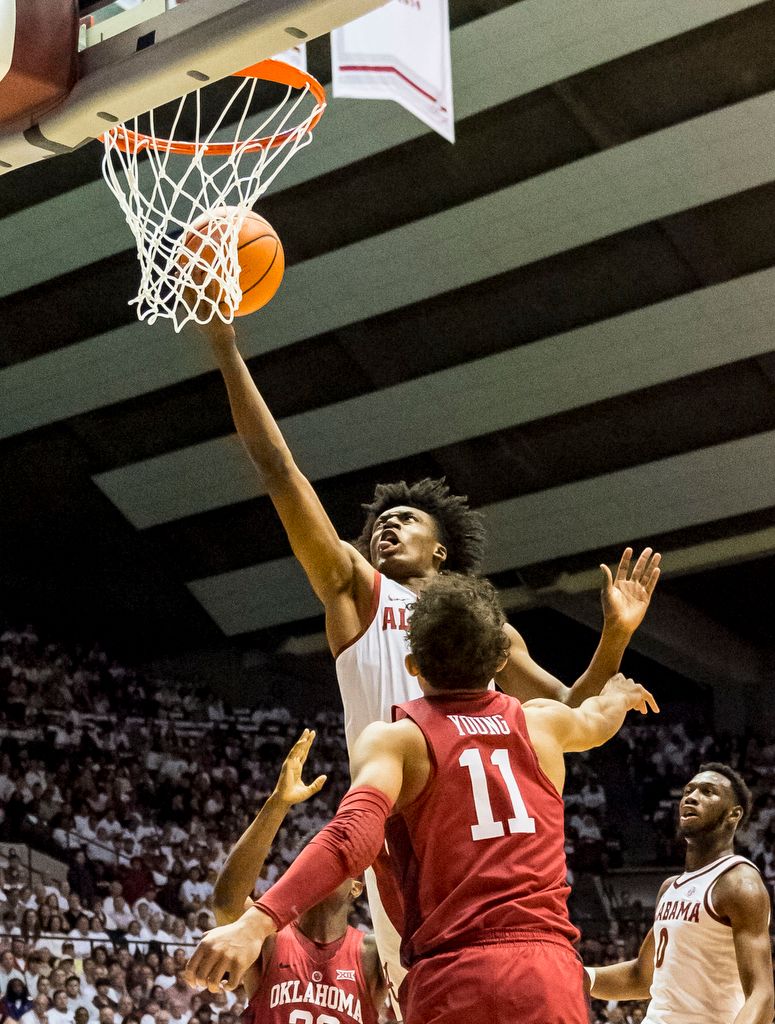
YOUNG’S SUPPORTING CAST HAS BEEN MISSING IN ACTION RECENTLY The primary reason as to why opponents’ new blueprint for Young has been so effective? Brady Manek, Christian James, and Kameron McGusty have been popping up on milk cartons more than they should be of late. Manek, the Sooners’ freshman pick-and-pop four, missed 6-of-7 three-pointers on Saturday, many of them wide open looks. Manek is 5-of-27 (19 percent) from long range in Oklahoma’s five losses, compared to 49 percent (39-of-79) in their 15 wins. James, another recipient of uncontested shots courtesy of Young’s deft slashing and passing ability, is 5-of-22 (23 percent) from distance in his last three games. McGusty is averaging a mere 3.5 points on a 33 percent shooting clip in his last six games. In his prior six contests, he was at 14.3 points on a 48 percent mark. Sour on Young, whose 38.4 Usage Rate leads the country, all you want. But, so long as he continues to willingly give the ball up when doubled—leading to 4-on-3 advantages for Oklahoma—and his teammates still fail to capitalize? That’s when you know he’s not the guy to point the finger at. (Compared to Youngs’, Sexton’s supporting cast is more talented and multidimensional. For instance, Dazon Ingram, not Sexton, leads Alabama in total assists this season.) COLLIN SEXTON IS GETTING BACK TO HIS YOUNG BULL WAYS Sexton only knows one level to play at. It’s an aggressive, attack-mode, balls-to-the-wall style for which we love him. But, with the Georgia native reportedly playing at less than 100 percent throughout the season and recently missing two games with an abdominal strain, we were left to witness a banged-up, watered-down version of Young Bull over the past few weeks. In his three immediate games prior to Saturday, he shot just 22 percent from the floor and averaged 9.0 points. He certainly looked healthier going up against Young. An unstoppable force in the open floor, Sexton had two strong finishes in transition early before having his way with Young in the paint in crunch time.Finally getting caught up on Oklahoma-Alabama. Here’s part of the blueprint to containing Trae Young: Make him give up ball as early as possible then deny return pass to him. Teams as athletic/long as Bama can afford to play 3-on-4 in these scenarios. pic.twitter.com/ZPg4skaetf
— Mike McCurry (@Mike_McCurry16) January 28, 2018
Some nights, I wake up in cold sweats, fresh out of a nightmare in which I imagine an NCAA Tournament without Sexton. That’s not going to be the case, though. Alabama was a 9-seed in ESPN’s latest Bracketology update, and that was before the Crimson Tide registered their third victory over an RPI Top-10 team by taking care of Oklahoma. EVERYONE’S FAVORITE PART: COMPARISONS FOR SEXTON & YOUNG During Saturday’s telecast, ESPN’s Fran Fraschilla compared Sexton to Kyle Lowry of the Toronto Raptors. ESPN draft analyst Mike Schmitz has likened Sexton’s measurables to Eric Bledsoe of the Milwaukee Bucks. Sexton, listed at 6-3 and 190 pounds, is a bigger, stronger prospect compared to the 6-2, 180-pound Young, not to mention a superior defender due to both physical (length, athleticism, speed/quickness) and mental (tenacity/will) qualities. Per Schmitz, Sexton thrives on “explosive downhill dashes to the rim” while profiling as a “physical, explosive athlete in terms of burst and leaping ability. Blur in the open court. Can finish above the rim.” Sexton is far from a polished jump shooter at this juncture. He made just 1-of-4 threes on Saturday, is connecting on only 27 percent of his triples in conference play, and hasn’t made multiple three-pointers since December 9 at Arizona. Schmitz further believes Sexton “would benefit from adding more craft finishes and floaters” to his arsenal.Slight nudge or not this is where Young will have to get better at the NBA level. Never going to offer much resistance from a physicality + length perspective but has to know tendencies, get by on smarts. pic.twitter.com/MuPcoKkCPP
— Mike Schmitz (@Mike_Schmitz) January 27, 2018
Young, meantime, has a baseline of Michael Conley Jr., according to Fraschilla. He has similar measurables to Tyus Jones of the Minnesota Timberwolves, per Schmitz (keep in mind, that’s not a skill comp). Even accounting for his recent contextual struggles, Young continues to lead the country in both points (29.6) and assists (9.6) per game. He’s knocking down 40 percent of his threes, despite close to half of his 209 three-point attempts being launched from 25-plus feet. According to Schmitz, Young has “Stephen Curry-esque deep pull-ups,” “gets by on deception and change of speeds rather than sheer explosiveness,” carries a “shoot-first mindset but can really facilitate when he chooses to,” and “has the ultimate green light and plays with very little fear.”Love Collin Sexton's floor as a prospect. NBA physical profile, plays both ends, hoops junkie who is going to continually get better, should live in the paint with NBA spacing. Not much downside.
— Mike Schmitz (@Mike_Schmitz) January 27, 2018
It’s no secret that Young is careless with the rock occasionally—he also happens to “lead” the nation with 105 turnovers—but he keeps the ball on a string and, at least up to this point, has been able to overcome his physical limitations via uncanny start-and-stop ability and a barrage of finishing varieties. *** Young and Sexton are quite dissimilar lead guards. Young said as much in December: “He’s [Sexton is] more athletic. He’s more downhill. I’m more skilled, I feel like…We just have totally different games.” Still, those two, along with 18-year-old Real Madrid point guard Luke Doncic (the top projected pick in ESPN’s mock draft), are potential franchise-changing point guards in the NBA. Let’s enjoy Young and Sexton while we still can. Follow Mike on Twitter Follow Adam Zagoria on Twitter And like ZAGS on Facebook Photo: AL.comHere's Young creating space vs an NBA athlete. Can be turnover prone but rarely gets sped up or changes face. Great footwork overall. pic.twitter.com/gqz7mYjc1B
— Mike Schmitz (@Mike_Schmitz) January 27, 2018





